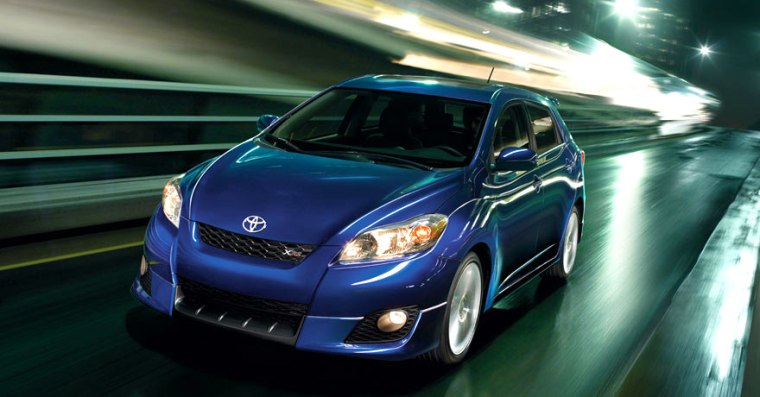For the past couple decades, when car shoppers sought a bit of extra elbow room, they got it by buying a car a class larger than their previous car. Within a couple purchase cycles the result was that everyone was driving full-size SUVs like the Chevy Suburban with the justification that they need some extra space for when they pick up their in-laws at the airport once a year or so.
Back when gas was only a buck a gallon (an all-time low price when adjusted for inflation) there seemed little motivation to buy smaller, and so the hatchback — the most practical and flexible vehicle body style — became virtually extinct. But today, with gas prices hovering at $4 a gallon, consumers want the smallest, most fuel-efficient car they can get their hand on, and they want it to have the most cabin space possible, so the hatchback is getting another look.
Enter the Toyota Matrix, which has received a complete makeover for its 2009 version. The Matrix is actually the five-door hatchback version of the Toyota Corolla, the world’s all-time best-selling nameplate, although unlike the Volkswagen Beetle and Ford Model T, it hasn’t been the same model sold for the whole production run. In the early years of production most Corollas were hatchbacks, but as the hatch fell out of favor the Corolla became a sedan-only model and Toyota introduced the Matrix as a Corolla variant, but called it a mini-crossover SUV because of available all-wheel-drive.
The 2009 Matrix has a couple more inches of headroom than the Corolla and it packs 114 cubic feet of passenger volume inside, compared to 92 cubic feet for the Corolla — this in a car that’s nearly seven inches shorter in length.
The Matrix is not only more practical than the Corolla, it also drives better. With the same hardware under the skin the reasons for this difference are not apparent, but an explanation may lie in the fact that both cars have switched to electric power steering from traditional hydraulic power steering for the 2009 refresh.
The Corolla is a case study for how not to execute electric power steering, possessing all the authentic road “feel” of the classic arcade driving game Pole Position played on your cell phone. The Matrix, despite the same hardware, feels much less disconnected. Consider it the equivalent of playing Pole Position on a vintage Atari game system with the steering wheel attachment — still unresponsive, but an improvement from driving by pressing phone buttons.

“It may have the body of a five-door hatch, but it comes with the soul of a two-door sports car,” claimed Tim Morrison, corporate marketing manager, perhaps inadvertently explaining Toyota’s historic lack of success in the sports car segment.
Even in the XRS top-of-the-line “sporty car” trim that I tested the Matrix feels top-heavy and rubbery. Attempting spirited driving in the Matrix feels like Venus Williams playing the French Open in those silly three-inch platform flip-flops instead of her sponsor’s tennis shoes.
The XRS features a more powerful 158-horsepower, 2.4-liter engine in place of the base model’s 132-horsepower, 1.8-liter engine. The mediocre fuel efficiency of the bigger engine (EPA combined driving rating of 24 MPG) with the 5-speed manual transmission I tested might suggest the 28 MPG base engine would be a smart choice.
But Toyota’s Yamaha-supplied 1.8-liter engine has the guts of the Cowardly Lion trapped in an Indiana Jones film, so it’s not worth the trade-off.
The Matrix’s clutch, brake and shifter all impart a rubbery vagueness that implies they are doing their respective jobs, but without offering the driver any firm assurances. Being Toyota employees, these components are all responsible adults, so their jobs do get done, and the lack of precise information about how it happens becomes tolerable after a while.
Toyota has been cutting corners on its interior fabrics and materials for a few years now, and as a product positioned toward the lower end of the company’s lineup the Matrix is particularly hard hit. Every surface inside the car seems as hard as Hillary Clinton’s steely resolve (and just as comforting).
The compact car market remains quite crowded with a number of contenders vying for purchase consideration. The Matrix faces a stiff challenge from quality alternatives, especially considering its price — the as-tested $22,480 sticker price indicates questionable fiscal prudence for a car that is supposed to be a near-entry-level machine.
Exercising some restraint will trim that price back dramatically. Opting for a more frugal base engine can save thousands compared to the top-of-the-line XRS version that I tested. Also in this price range are the excellent Mazda3, Saturn Aura and Volkswagen Rabbit — all available as five-door hatches. If the quasi-SUV aspect of the Matrix and its available all-wheel-drive are the source of your interest, look hard at the Subaru Forester. And if thrifty family hauling is your purpose, ignore the uncool sliding doors and take a look at the Mazda5. All of these vehicles are more engaging to drive than the Matrix and should be seriously considered.
But for the boomer-generation faithful who automatically return to the Toyota store like salmon churning upstream in the Columbia River, the Matrix is a great choice. It’s the best Corolla that Toyota sells, thanks to its flexible hatchback body style and seemingly better executed steering and suspension tuning.
One last thing to consider is that Pontiac dealers sell a rebadged version of the Matrix called the Vibe. It is bolted together on the very same Fremont, Calif., assembly line as the Toyota Corolla and the Pontiac benefits from General Motors’ generous powertrain warranty and whatever sales incentives Pontiac dealers may offer to help them sell cars, which can make that version a better deal.
Yes, I understand that some people have an aversion to the adolescent image the Pontiac brand evokes, but you’ll have to decide whether that image is enough to forego a longer warranty on the engine and transmission.
